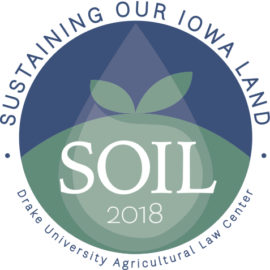Posted on March 14, 2019
Watershed Citizenship
Professor Neil D. Hamilton presented “Watershed Citizenship” at the 19th Annual Water Conference at Iowa State University on March 12, 2019.
Citizenship is premised on being part of something – there is an implicit aspect of mutuality and reciprocity.
Watersheds are an excellent vehicle to apply the ideals of citizenship and this is especially true for HUC 12 watersheds because they share these eight traits:
- the proximity—we live in them
- the scale—they average 22,000 acres
- our awareness and knowledge—they are our neighborhoods
- the visibility—we can see them
- the objective measurability—we can measure them
- our identifiable impact—we can change how they perform
- the personal relations—we know the people who live there, and
- the human dimension—they are influenced by our actions.
Watershed Citizenship broadens the focus from the individual to a community. Watershed Citizenship helps us consider the moral hazard of seeing Water Quality as a “downstream” issue – someone else’s worry. In a watershed, we are upstream from some and downstream from others. This reflects the reciprocity of citizenship and how it is premised on the Golden Rule – the idea we should treat others how we want to be treated.
As I look at the future of our water quality efforts I am left with many questions. If we are good watershed citizens, why aren’t we doing more to protect and improve our water? Why are we happy with the meagre funding, with the relative few demonstration projects, and with only a fraction of our fellow citizens being engaged?
We have staked our future on the NRS – an interesting scientific document but one deeply flawed from a policy perspective. Nothing about the NRS is bold or imaginative – in fact, we only developed it because the EPA forced us to.
How different might an Iowa water quality strategy look if we developed an NRS 2.0 – one based on the context of our laws, on our legacy of conservation leadership – and on the ideals of Watershed Citizenship?
- Why can’t we ask and expect each farmer and landowner to have a water quality plan?
- Why can’t we have more HUC 12 watershed projects underway? I reviewed the water quality projects and demonstrations for this talk – and can identify at most 34 county Soil and Water Conservation Districts involved in a HUC 12 project. Why can’t we expect each SWCD to have at least one HUC 12 project underway?
- Why don’t the agriculture and conservation groups urge the legislature to fund the Natural Resources Trust Fund so we have adequate funds to actually make progress?
- Why can’t we empower the drainage districts and engage them to use their reach and authority to improve water quality?
I suggest the following lessons I learned from the restoration of Lake Darling—we need a sense of urgency, a vision, and priorities. We need ways to measure progress, community support, and adequate funding. We need cooperation from farmers and landowners working at the local watershed level. We need to engage the structures and institutions we have in place – the Soil and Water Conservation districts, drainage districts and watershed authorities. We need leadership—people willing to invest their time and reputations – and willing to confront the dogma we may need to overcome.
When we do so, we will have used the ideals of citizenship and the organizational potential of watersheds to unleash the power of Watershed Citizenship.
__________________________________________________________________________________
To read the full script of Neil Hamilton’s Watershed Citizenship presentation, go to http://aglawcenter.wp.drake.edu/wp-content/uploads/sites/99/2019/03/Watershed-Citizenship.pdf




Pingback: In a word: overwhelming.